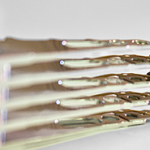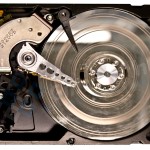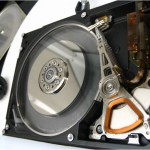Barriers to Hard Drive Data Recovery: Rotational Scoring
Updated 7/8/2015
One important question clients ask when considering data recovery is: “How likely will a successful data recovery be?”
For us, the answer depends mostly on whether or not the data still exists. That seems obvious in hindsight.
But First, How Is the Data Stored?
The data on a hard drive is stored on one or more hard discs, or platters, made of glass or aluminum. These platters are coated with an extremely thin mirror-like coating of magnetic material. This surface has tiny individual areas, each of which has two possible states.
The state is changed by the hard drive’s read/write heads when a small electrical field is applied, creating an incredibly dense matrix of magnetized or unmagnetized spots — 1’s and 0’s. That’s your data. On a basic level, this data is stored using electromagnetism.

The magnetic material on the platters is delicate. Under normal operation, the read/write heads are positioned over the platter by an arm (picture the arm on a record player), but they move quickly across the platter without contacting the platter surface.
Instead, they float on an extremely thin — as in 3-5 nanometers — cushion of air. To give a sense of scale, an oxygen molecule is about a third of a nanometer.
When the hard drive spins up, the motion of the platters creates airflow. The read/write head assembly is designed roughly like a small wing and the airflow generated inside the drive lifts the heads off the platter. So I guess indirectly, we can thank the Wright Bros. for their help in developing modern hard drives (and we can directly thank IBM for inventing the first hard drive in 1956).
When Worlds Collide (and Heads Crash)
In some situations, the read/write head loses lift and crashes onto the platter surface. This action is commonly referred to as a head crash. In most situations, the head will briefly make contact, immediately lift back up, and the drive will go on working with no noticeable impact to the user.

Unfortunately, sometimes a head crash damages the head. Instead of lifting back up, the heads may remain in contact with the delicate platter surface.
The platter spins at some constant, high rotational speed. A common rotational speed is 7,200 revolutions per minute, but drives range from 5,400 to15,000 rpm. This rotational velocity combined with contact from the heads is what causes rotational scoring.
When that magnetic material gets scored, the magnetic coating is turned to dust. The data it carried is lost. All those 1’s and 0’s, all that potentially precious information, gone forever.
In extreme cases of rotational scoring, we have seen large portions of laptop hard drive platters exposed as bare glass. This means that nearly all the magnetic material from a vast portion of the drive has been scratched off by the read/write head.
Some minor rotational scoring can be overcome by advanced techniques to recover data elsewhere on the drive’s platters. Unfortunately, any significant scoring is very likely to remove key parts of metadata necessary to make sense of the remaining binary code.
Rotational scoring also creates an uneven surface on the platter, meaning even if you replace a damaged read/write head, the new one can become damaged again by slamming into the uneven portions of the platter. Fortunately, our handy-dandy (and state-of-the-art) burnishing machine can help mitigate this problem.
In summary, if your hard drive experiences some rotational scoring, it might not be the end of the world. The data may still be recoverable, in which case please feel free to get in touch with us.
Just try not to move, kick, or drop a hard drive while it’s operating and you’ve greatly improved your chances of avoiding rotational scoring.

